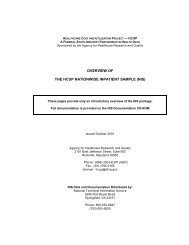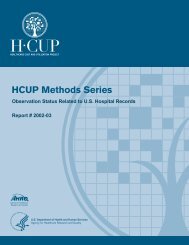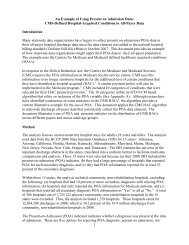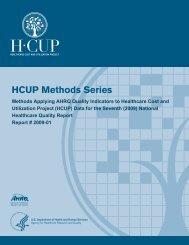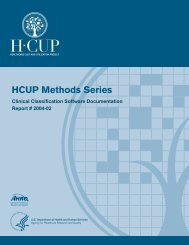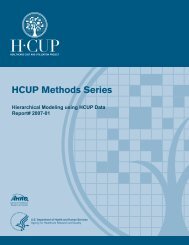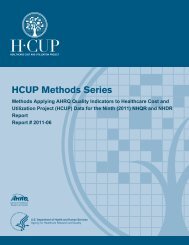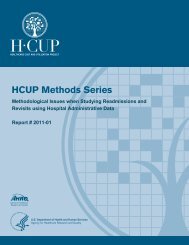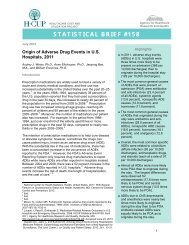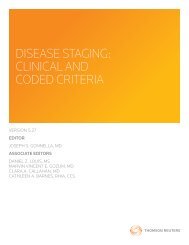Introduction to the HCUP Nationwide Inpatient Sample (NIS)
Introduction to the HCUP Nationwide Inpatient Sample (NIS)
Introduction to the HCUP Nationwide Inpatient Sample (NIS)
You also want an ePaper? Increase the reach of your titles
YUMPU automatically turns print PDFs into web optimized ePapers that Google loves.
frame (i.e., having zero probability of selection). Moreover, this sample was <strong>to</strong> be geographically<br />
dispersed, yet drawn only from data supplied by <strong>HCUP</strong> Partners.<br />
It should be possible, for example, <strong>to</strong> estimate DRG-specific average lengths of stay across all<br />
U.S. hospitals using weighted average lengths of stay, based on averages or regression<br />
coefficients calculated from <strong>the</strong> <strong>NIS</strong>. Ideally, relationships among outcomes and <strong>the</strong>ir correlates<br />
estimated from <strong>the</strong> <strong>NIS</strong> should accurately represent all U.S. hospitals. It is advisable <strong>to</strong> verify<br />
your estimates against o<strong>the</strong>r data sources, if available, because not all States contribute data <strong>to</strong><br />
<strong>the</strong> <strong>NIS</strong>. Table 2 in Appendix I lists <strong>the</strong> number of <strong>NIS</strong> States, hospitals, and discharges by year.<br />
For example, <strong>the</strong> National Hospital Discharge Survey (http://www.cdc.gov/nchs/nhds.htm) can<br />
provide benchmarks against which <strong>to</strong> check your national estimates for hospitalizations with<br />
more than 5,000 cases.<br />
The <strong>NIS</strong> Comparison Report assesses <strong>the</strong> accuracy of <strong>NIS</strong> estimates by providing a<br />
comparison of <strong>the</strong> <strong>NIS</strong> with o<strong>the</strong>r data sources. The most recent report is available on <strong>the</strong><br />
<strong>HCUP</strong>-US Website (http://www.hcup-us.ahrq.gov/db/nation/nis/nisrelatedreports.jsp).<br />
The <strong>NIS</strong> team considered alternative stratified sampling allocation schemes. However,<br />
allocation proportional <strong>to</strong> <strong>the</strong> number of hospitals was preferred for several reasons:<br />
• AHRQ researchers wanted a simple, easily unders<strong>to</strong>od sampling methodology. The<br />
concept that <strong>the</strong> <strong>NIS</strong> sample could represent a "miniaturization" of <strong>the</strong> hospital universe<br />
was appealing. There were, however, obvious geographic limitations imposed by data<br />
availability.<br />
• AHRQ statisticians considered o<strong>the</strong>r optimal allocation schemes, including sampling<br />
hospitals with probabilities proportional <strong>to</strong> size (number of discharges). They ultimately<br />
concluded that sampling with probability proportional <strong>to</strong> <strong>the</strong> number of hospitals was<br />
preferable. While this approach was admittedly less efficient, <strong>the</strong> extremely large sample<br />
sizes yield reliable estimates. Fur<strong>the</strong>rmore, because <strong>the</strong> data are <strong>to</strong> be used for<br />
purposes o<strong>the</strong>r than producing nationwide estimates, (e.g., regression modeling), it is<br />
critical that all hospital types, including small hospitals, are adequately represented.<br />
Overview of <strong>the</strong> Sampling Procedure<br />
To fur<strong>the</strong>r ensure accurate geographic representation, we implicitly stratified <strong>the</strong> hospitals by<br />
State and three-digit ZIP Code (<strong>the</strong> first three digits of <strong>the</strong> hospital's five-digit ZIP Code). This<br />
was accomplished by sorting by three-digit ZIP Code within each stratum prior <strong>to</strong> drawing a<br />
systematic random sample of hospitals.<br />
After stratifying <strong>the</strong> universe of hospitals, we sorted hospitals by stratum, <strong>the</strong> three-digit ZIP<br />
Code within each stratum, and by a random number within each three-digit ZIP Code. These<br />
sorts ensured fur<strong>the</strong>r geographic generalizability of hospitals within <strong>the</strong> frame States, as well as<br />
random ordering of hospitals within three-digit ZIP Codes. Generally, three-digit ZIP Codes that<br />
are proximal in value are geographically near one ano<strong>the</strong>r within a State. Fur<strong>the</strong>rmore, <strong>the</strong> U.S.<br />
Postal Service locates regional mail distribution centers at <strong>the</strong> three-digit level. Thus, <strong>the</strong><br />
boundaries tend <strong>to</strong> be a compromise between geographic size and population size.<br />
We <strong>the</strong>n drew a systematic random sample of up <strong>to</strong> 20% of <strong>the</strong> <strong>to</strong>tal number of U.S. hospitals<br />
within each stratum. If <strong>to</strong>o few frame hospitals appeared in a cell, we selected all frame<br />
hospitals for <strong>the</strong> <strong>NIS</strong>, subject <strong>to</strong> sampling restrictions specified by States. To simplify variance<br />
<strong>HCUP</strong> <strong>NIS</strong> (09/06/2011) 23 <strong>Introduction</strong>



